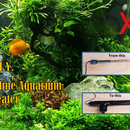Introduction: Mowing Difficult Slopes
These fantastic devices come under many names depending on what country you live in. Weed whackers, weed eaters, line trimmers, edge trimmers to name a few, but here in the Land of Oz, they are generally referred to as whipper snippers.
I'm a relatively keen gardener and like to keep all my grass mown at a neat and tidy level. My property backs onto a river and as I’m not as young as I used to be, I’m finding it harder to keep my footing when using my whipper snipper on the steeper slopes and not end up in the drink.
Supplies
An old whipper snipper. Discarded ones like mine are the best, providing there is not too much wrong with it. It's amazing what people through out these days.
Three castors ( I bought mine new from the local hardware for $6.50 each.
Some scrap ply wood.
A pole to attach your gizmo to. I used an old pool net handle.
Step 1: Seeing If It Is Worth Salvaging
I've had an idea for many years now, thinking perhaps it would be a lot easier if I could mow the grass on those steeper parts like you would use a vacuum cleaner.
With that idea in mind, my eyes lit up when I saw that a neighbour of mine had left a broken whipper snipper out on the footpath during our annual rubbish collection pick up.
The fuel tank had snapped off, the plastic fuel primer and pipes had perished and the throttle cable had seized due to rust. Never the less, I thought it was worth salvaging to see if I could bring it back to its former glory.
After replacing the fuel lines and primer, and repairing the broken aluminium fuel tank mounts with JB Weld glue, I filled it up with some two stroke fuel and yanked on the starter cord. A big smile appeared on my dial when she kicked into life.
Step 2: Pulling It Apart
I then began dismantling it to see if it was possible to fix the motor directly to the bevel gear and trimmer head and do away with everything else in between.
I was presently surprised to see that it all looked pretty straight forward. All I needed to do was shorten the pole shaft, cable spacer and the internal flex drive cable.
Step 3: Joining the Motor to the Business End
Cutting the pole shaft was easy enough as I already had a pipe cutter. The spacer (which keeps the flexi cable relatively straight preventing it from rattling around inside the shaft) is made of plastic so no problems there either. The flexi cable consisted of multiple strands of wire with 8 lengths of a slightly larger gauge wire wrapped tightly around to form a flexible cable. The cable had been stamped into a 6mm square form at both ends for it to engage with the motor at one end and bevel gear at the other.
I used a hacksaw to cut off a section. The cut end had to be squared off to fit either the motor end or the bevel gear. I performed this task with a metal file. Care needs to be taken to file in the direction of the twist to avoid the outer wires from unravelling. It was then just the simple task of joining the components together.
Step 4: Making Up the Mower Deck
I chose a piece of 15mm thick scrap 4-ply sheeting as a base. The radius of the trimmer line was roughly 200mm, so I cut the board into the shape of an equilateral triangle with 700mm sides. I figured the fewer wheels on the ground the better when pushing the unit through grass and a triangle would also be relatively stable. The wheels would also have to be a reasonable size, so went with 100mm castors. I cut the points off at 100mm for no other reason in that this was the width of the castor mounting plate and to tidy it up as well.
Step 5: Setting the Line Trimmer Height
The trimmer head mounted on this board was way too high to cut the grass down to a reasonable height so I fixed the motor to a second board suspended beneath the first with hardwood dowel as shown. The trimmer lines were now about 10mm off the ground which should result in a nice grass height.
Step 6: All Done
Step 7: Adding the Pole
For a handle, I used an old aluminium pool pole I found amongst all the junk I hang on to. I attached the pole to the wooden base with a hinge bracket and we were in business.
Step 8: The Beast in Action

Participated in the
Trash to Treasure Contest











